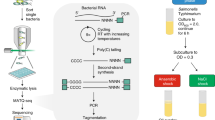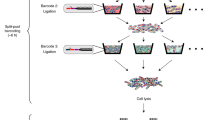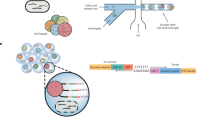Abstract
Transcriptome-wide studies in eukaryotes have been instrumental in the characterization of fundamental regulatory mechanisms for more than a decade. By contrast, in prokaryotes (bacteria and archaea) whole-transcriptome studies have not been performed until recently owing to the general view that microbial gene structures are simple, as well as technical difficulties in enriching for mRNAs that lack poly(A) tails. Deep RNA sequencing and tiling array studies are now revolutionizing our understanding of the complexity, plasticity and regulation of microbial transcriptomes.
This is a preview of subscription content, access via your institution
Access options
Subscribe to this journal
Receive 12 print issues and online access
$189.00 per year
only $15.75 per issue
Buy this article
- Purchase on Springer Link
- Instant access to full article PDF
Prices may be subject to local taxes which are calculated during checkout



Similar content being viewed by others
References
Strausberg, R. L. & Riggins, G. J. Navigating the human transcriptome. Proc. Natl Acad. Sci. USA 98, 11837–11838 (2001).
Wang, Z., Gerstein, M. & Snyder, M. RNA-Seq: a revolutionary tool for transcriptomics. Nature Rev. Genet. 10, 57–63 (2009).
Xing, Y. & Lee, C. Alternative splicing and RNA selection pressure — evolutionary consequences for eukaryotic genomes. Nature Rev. Genet. 7, 499–509 (2006).
Misra, S. et al. Annotation of the Drosophila melanogaster euchromatic genome: a systematic review. Genome Biol. 3, research0083 (2002).
Kiyosawa, H., Yamanaka, I., Osato, N., Kondo, S. & Hayashizaki, Y. Antisense transcripts with FANTOM2 clone set and their implications for gene regulation. Genome Res. 13, 1324–1334 (2003).
Yelin, R. et al. Widespread occurrence of antisense transcription in the human genome. Nature Biotech. 21, 379–386 (2003).
He, Y., Vogelstein, B., Velculescu, V. E., Papadopoulos, N. & Kinzler, K. W. The antisense transcriptomes of human cells. Science 322, 1855–1857 (2008).
Neidhardt, F. C. et al. Escherichia coli and Salmonella: Cellular and Molecular Biology (ed. Neidhardt, F. C.) 13–16 (ASM Press, Washington, DC, 1996).
Bryant, P. A., Venter, D., Robins-Browne, R. & Curtis, N. Chips with everything: DNA microarrays in infectious diseases. Lancet Infect. Dis. 4, 100–111 (2004).
Passalacqua, K. D. et al. The structure and complexity of a bacterial transcriptome. J. Bacteriol. 191, 3203–3211 (2009).
Perkins, T. T. et al. A strand-specific RNA-Seq analysis of the transcriptome of the typhoid bacillus Salmonella Typhi. PLoS Genet. 5, e1000569 (2009).
Sittka, A. et al. Deep sequencing analysis of small noncoding RNA and mRNA targets of the global post-transcriptional regulator, Hfq. PLoS Genet. 4, e1000163 (2008).
Yoder-Himes, D. R. et al. Mapping the Burkholderia cenocepacia niche response via high-throughput sequencing. Proc. Natl Acad. Sci. USA 106, 3976–3981 (2009).
Guell, M. et al. Transcriptome complexity in a genome-reduced bacteria. Science (in the press).
Wurtzel, O. et al. A single-base resolution map of an archaeal transcriptome Genome Res. 2 Nov 2009 (doi:10.1101/gr.100396.109).
Selinger, D. W. et al. RNA expression analysis using a 30 base pair resolution Escherichia coli genome array. Nature Biotech. 18, 1262–1268 (2000).
McGrath, P. T. et al. High-throughput identification of transcription start sites, conserved promoter motifs and predicted regulons. Nature Biotech. 25, 584–592 (2007).
Toledo-Arana, A. et al. The Listeria transcriptional landscape from saprophytism to virulence. Nature 459, 950–956 (2009).
Koide, T. et al. Prevalence of transcription promoters within archaeal operons and coding sequences. Mol. Syst. Biol. 5, 285 (2009).
Rasmussen, S., Nielsen, H. B. & Jarmer, H. The transcriptionally active regions in the genome of Bacillus subtilis. Mol. Microbiol. 73, 1043–1057 (2009).
Frias-Lopez, J. et al. Microbial community gene expression in ocean surface waters. Proc. Natl Acad. Sci. USA 105, 3805–3810 (2008).
McHardy, A. C., Goesmann, A., Puhler, A. & Meyer, F. Development of joint application strategies for two microbial gene finders. Bioinformatics 20, 1622–1631 (2004).
Overbeek, R., Bartels, D., Vonstein, V. & Meyer, F. Annotation of bacterial and archaeal genomes: improving accuracy and consistency. Chem. Rev. 107, 3431–3447 (2007).
Coppins, R. L., Hall, K. B. & Groisman, E. A. The intricate world of riboswitches. Curr. Opin. Microbiol. 10, 176–181 (2007).
Waters, L. S. & Storz, G. Regulatory RNAs in bacteria. Cell 136, 615–628 (2009).
Mandal, M., Boese, B., Barrick, J. E., Winkler, W. C. & Breaker, R. R. Riboswitches control fundamental biochemical pathways in Bacillus subtilis and other bacteria. Cell 113, 577–586 (2003).
Hammann, C. & Westhof, E. Searching genomes for ribozymes and riboswitches. Genome Biol. 8, 210 (2007).
Brenneis, M., Hering, O., Lange, C. & Soppa, J. Experimental characterization of cis-acting elements important for translation and transcription in halophilic archaea. PLoS Genet. 3, e229 (2007).
Brenneis, M. & Soppa, J. Regulation of translation in haloarchaea: 5′- and 3′-UTRs are essential and have to functionally interact in vivo. PLoS ONE 4, e4484 (2009).
Mao, F., Dam, P., Chou, J., Olman, V. & Xu, Y. DOOR: a database for prokaryotic operons. Nucleic Acids Res. 37, D459–D463 (2009).
Bejerano-Sagie, M. & Xavier, K. B. The role of small RNAs in quorum sensing. Curr. Opin. Microbiol. 10, 189–198 (2007).
Masse, E., Salvail, H., Desnoyers, G. & Arguin, M. Small RNAs controlling iron metabolism. Curr. Opin. Microbiol. 10, 140–145 (2007).
Toledo-Arana, A., Repoila, F. & Cossart, P. Small noncoding RNAs controlling pathogenesis. Curr. Opin. Microbiol. 10, 182–188 (2007).
Aiba, H. Mechanism of RNA silencing by Hfq-binding small RNAs. Curr. Opin. Microbiol. 10, 134–139 (2007).
Livny, J. & Waldor, M. K. Identification of small RNAs in diverse bacterial species. Curr. Opin. Microbiol. 10, 96–101 (2007).
Zhang, A. et al. Global analysis of small RNA and mRNA targets of Hfq. Mol. Microbiol. 50, 1111–1124 (2003).
Lavorgna, G. et al. In search of antisense. Trends Biochem. Sci. 29, 88–94 (2004).
Brantl, S. Regulatory mechanisms employed by cis-encoded antisense RNAs. Curr. Opin. Microbiol. 10, 102–109 (2007).
Georg, J. et al. Evidence for a major role of antisense RNAs in cyanobacterial gene regulation. Mol. Syst. Biol. 5, 305 (2009).
Liu, J. M. et al. Experimental discovery of sRNAs in Vibrio cholerae by direct cloning, 5S/tRNA depletion and parallel sequencing. Nucleic Acids Res. 37, e46 (2009).
Loh, E. et al. A trans- acting riboswitch controls expression of the virulence regulator PrfA in Listeria monocytogenes. Cell 139, 770–779 (2009).
Pace, N. R. A molecular view of microbial diversity and the biosphere. Science 276, 734–740 (1997).
Tringe, S. G. & Rubin, E. M. Metagenomics: DNA sequencing of environmental samples. Nature Rev. Genet. 6, 805–814 (2005).
Tringe, S. G. et al. Comparative metagenomics of microbial communities. Science 308, 554–557 (2005).
DeLong, E. F. et al. Community genomics among stratified microbial assemblages in the ocean's interior. Science 311, 496–503 (2006).
Rusch, D. B. et al. The Sorcerer II Global Ocean Sampling expedition: northwest Atlantic through eastern tropical Pacific. PLoS Biol. 5, e77 (2007).
DeLong, E. F. The microbial ocean from genomes to biomes. Nature 459, 200–206 (2009).
Warnecke, F. et al. Metagenomic and functional analysis of hindgut microbiota of a wood-feeding higher termite. Nature 450, 560–565 (2007).
Poretsky, R. S. et al. Analysis of microbial gene transcripts in environmental samples. Appl. Environ. Microbiol. 71, 4121–4126 (2005).
Leininger, S. et al. Archaea predominate among ammonia-oxidizing prokaryotes in soils. Nature 442, 806–809 (2006).
Gilbert, J. A. et al. Detection of large numbers of novel sequences in the metatranscriptomes of complex marine microbial communities. PLoS ONE 3, e3042 (2008).
Urich, T. et al. Simultaneous assessment of soil microbial community structure and function through analysis of the meta-transcriptome. PLoS ONE 3, e2527 (2008).
Shi, Y., Tyson, G. W. & DeLong, E. F. Metatranscriptomics reveals unique microbial small RNAs in the ocean's water column. Nature 459, 266–269 (2009).
Kaern, M., Elston, T. C., Blake, W. J. & Collins, J. J. Stochasticity in gene expression: from theories to phenotypes. Nature Rev. Genet. 6, 451–464 (2005).
Tang, F. et al. mRNA-Seq whole-transcriptome analysis of a single cell. Nature Methods 6, 377–382 (2009).
Mao, C., Evans, C., Jensen, R. V. & Sobral, B. W. Identification of new genes in Sinorhizobium meliloti using the Genome Sequencer FLX system. BMC Microbiol. 8, 72 (2008).
Amara, R. R. & Vijaya, S. Specific polyadenylation and purification of total messenger RNA from Escherichia coli. Nucleic Acids Res. 25, 3465–3470 (1997).
Wendisch, V. F. et al. Isolation of Escherichia coli mRNA and comparison of expression using mRNA and total RNA on DNA microarrays. Anal. Biochem. 290, 205–213 (2001).
Acknowledgements
We thank O. Wurtzel and A. Levy for stimulating comments. R.S. is supported, in part, by the Israel Science Foundation Focal Initiatives in Research in Science and Technology (FIRST) program (grant 1615/09), the Crown Human Genome Center, the Y. Leon Benoziyo Institute for Molecular Medicine and the M.D. Moross Institute for Cancer Research at the Weizmann Institute of Science, as well as the Alon Fellowship. P.C. is a Howard Hughes International Scholar. She has received financial support for her work on RNA from the Agence Nationale de la Recherche, the European Union (BacRNA 2005-018618) and recently from the European Research Council.
Author information
Authors and Affiliations
Corresponding author
Ethics declarations
Competing interests
The authors declare no competing financial interests.
Related links
Glossary
- Expressed sequence tag
-
A fragment of cDNA that is generated using random shotgun sequencing of the transcriptome.
- Genomic tiling array
-
A DNA microarray that uses a set of overlapping oligonucleotide probes that cover the whole genome or a proportion of the genome at high resolution.
- Polycistronic mRNA
-
An mRNA (also known as a polycistron) that encodes several polypeptides. Polycistronic transcripts are common in bacteria.
- Quorum sensing
-
A mechanism used by many bacteria to detect a critical bacterial cell density. Some genes are only expressed at high cell density. Cell densities are proportional to the concentration of small molecules or peptides (autoinducers) that are secreted by the bacteria in the medium. These molecules coordinate the expression of specific genes — for example, virulence genes in pathogenic bacteria.
- Riboswitch
-
An RNA element that is located at the 5′ end of an mRNA and that can adopt alternative structures. When a riboswitch binds a metabolite, metal or even a tRNA, the transcription of the downstream gene or, in some cases, the translation of the gene is inhibited.
- RNA–seq
-
An approach for whole-transcriptome profiling in which a population of RNA is converted to cDNA and subjected to high-throughput sequencing. Sequences are mapped to the genome to generate a high-resolution transcriptome map.
Rights and permissions
About this article
Cite this article
Sorek, R., Cossart, P. Prokaryotic transcriptomics: a new view on regulation, physiology and pathogenicity. Nat Rev Genet 11, 9–16 (2010). https://doi.org/10.1038/nrg2695
Published:
Issue Date:
DOI: https://doi.org/10.1038/nrg2695
This article is cited by
-
Influence of gut microbiome on health and development of penaeid shrimps
Aquatic Sciences (2024)
-
Droplet-based high-throughput single microbe RNA sequencing by smRandom-seq
Nature Communications (2023)
-
Expressions of resistome is linked to the key functions and stability of active rumen microbiome
Animal Microbiome (2022)
-
Nitrogen source as a modulator of the metabolic activity of Pedobacter lusitanus NL19: a transcriptomic approach
Applied Microbiology and Biotechnology (2022)
-
Next-generation microbiology: from comparative genomics to gene function
Genome Biology (2021)



